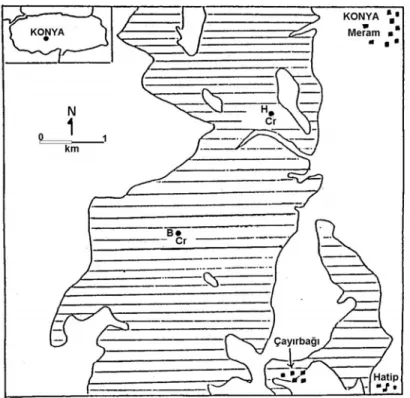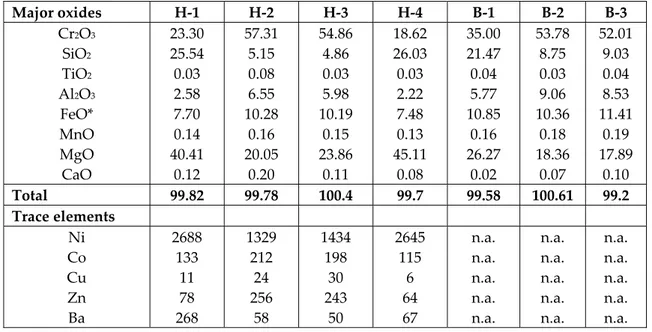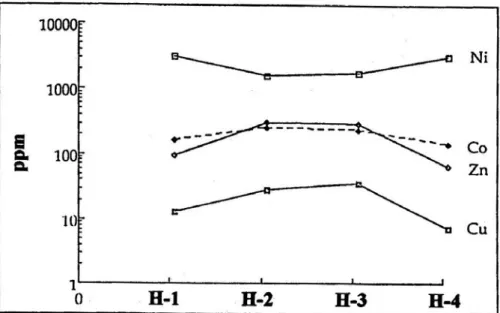CHROMITE OCCURRENCES IN THE MERAM-ÇAYIRBAĞI OPHIOLITES (KONYA, TURKEY): GEOLOGICAL AND GEOCHEMICAL OUTLINE
Veysel ZEDEF
S.Ü., Mühendislik-Mimarlık Fakültesi, Maden Müh. Bölümü, Kampüs-KONYA (vzedef@selcuk.edu.tr)
Makalenin Geliş Tarihi: 24.09.2003
ABSTRACT: Two chromite occurrences have been found within the Meram-Çayırbağı (Konya)
Ophiolitic Complex. The occurrences are located at Helvacıbaba and Bacağınkoyak Tepe, and the complex is promising for large chromite orebodies. The chromites are formed in dunitic rocks of the Meram-Çayırbağı Ophiolites. Chromite mineralization of >18.62 % (in weight) occurs in Helvacıbaba while the Bacağınkoyak Tepe have a minimum 35 % of Cr2O3. The major and trace element data of both occurrences indicate that the chemical composition of the chromite samples is mainly controlled by the Cr2O3 concentration.
Key words: Ophiolite, chromite, Meram-Çayırbağı, Konya, Turkey
Meram-Çayırbağı (Konya-Türkiye) Ofiyolitlerindeki Kromit Oluşumları: Jeolojik ve Jeokimyasal Özellikler
ÖZET: Meram-Çayırbağı (Konya) ofiyolit karmaşığı içinde iki kromit zuhuru bulunmuştur. Zuhurlar
Helvacıbaba ve Bacağınkoyak Tepeʹde yer almakta olup ofiyolitik karmaşık büyük kromit yatakları için ümit vericidir. Kromitler Meram-Çayırbağı ofiyolitlerinin dunitik kayaçları içinde bulunur. Helvacıbaba zuhurunda kromit oranı %18.62 (ağırlık olarak)ʹden daha büyükken Bacağınkoyak Tepe zuhuru minimum %35 Cr2O3 içermektedir. Her iki zuhurdaki kromitlerin ana ve iz element verileri kromit numunelerinin kimyasal bileşimlerinin Cr2O3 konsantrasyonu itarafından kontrol edildiğine işaret etmektedir.
Anahtar kelimeler: Ofiyolit, kromit, Meram-Çayırbağı, Konya, Türkiye
INTRODUCTION
The ophiolitic complexes of Turkey, cropping out in the Anatolian portion of the Alpine Orogenic Belt, cover an area of about 60.000 km2.
These complexes are discontinuously scattered all over the country. The ultramafic rocks as parental rocks of chromites occur mainly within the ophiolites. The emplacement of ophiolites in the Anatolian Peninsula is mostly related to Alpine Orogeny. They originated between the time intervals of Late Paleozoic and Cretaceous, but were emplaced, most likely at Late Cretaceous. Chromite grains are ubiquitously present in the ultramafic rocks of all the
ophiolites of Turkey. The Meram-Çayırbağı ophiolitic complex has long been known because it comprises one of the largest magnesite orebodies of Turkey and even Europe and Middle East. But the chromite occurrences within the complex have almost no attention by the authors despite their easily visible exposures in the field.
The Meram-Çayırbağı ophiolitic complex is spread over 20 km x 10 km area in the central south-west of the country (south-west of Konya). The geological mapping has revealed that the thickness of the ophiolitic slides may reach up to 900 m (Zedef, 1994). The ophiolitic rocks were tectonically abducted during Maastrichtian time
upon the Paleozoic and Mesozoic carbonates. However, there is no trace of contact metamorphism between the ophiolites and the other rocks. Tertiary conglomerates with magnesite pebbles and limestones unconformably overlie the ophiolites. Ophiolitic rocks comprise dunite, harzburgite, gabbro, troctolite and pyroxenite, but gabbro, troctolite and pyroxenite have a limited presence in the field. The dunit and harzburgite are serpentinized, carbonated and even silicified at most places. The ophiolitic rocks are strongly deformed and cataclastisized. Indication of strong deformation on ultramafic rocks can be seen at most of the ultramafic belts of Turkey (Zedef et al, 1994, Koçak et al., 2001; Döyen and Zedef, 2002).
The main aim of this paper is to report the existence of chromite occurrences (may be in economic interest) in the Meram-Çayırbağı ophiolites and present their some geological and geochemical features.
Chromite Occurance in the Complex
Two small chromite orebodies have been observed in dunitic rocks of the Meram-Çayırbağı ophiolites. The one is at Helvacıbaba, the other is at Bacağınkoyak Tepe (Figure 1). For a detailed geological setting see Zedef, 1994. Reserve is unknown at both localities as the ex-exploration programs centered on the magnesite deposits. But in the light of the field observations, a few tens of tons of chromite ores may be found in the occurrences. It is worth to stress the fact that the detailed explorations for chromite may possibly extend this tonnage up to thousands of tons of chromite since some chromite grains observed in the stream-beds of the area have similar textural features with the chromites described below.
In the Helvacıbaba, the chromite grains are distributed (as disseminated ore) in the groundmass of gangue minerals (mainly olivine). On the other hand, the Bacağınkoyak
Figure 1. Location map of the Helvacıbaba (H) and Bacağınkoyak Tepe (B) chromite occurrences within
the Meram-Çayırbağı ophiolitic complex (dashed area). The boundary of the ophiolitic complex is modified from Zedef (1994).
Şekil 1. Meram-Çayırbağı ofiyolit kompleksi (taralı alan) içinde yeralan Helvacıbaba (H) ve Bacağınkoyak Tepe
(B) kromit zuhurları yerbulduru haritası. Ofiyolit kompleksinin sınırları Zedef (1994)ʹden değiştirilerek uyarlanmıştır.
Tepe chromites have a massive character. With the exception of the textural differences, microscopic features of the chromitiferous samples are almost identical at both localities. Coarse to fine-grained subidiomorphic granular texture has been observed in the chromite samples under the reflected light. Extensive brecciation and granulation are well-developed in the chromite grains. Thus, highly angular or elongated fragments were produced. Both fractures and boundary of the grains were cemented either by olivine and/or by fine grains of chromite. Intense to mild fracturing without preferred orientation is a very common feature in all chromite samples.
Geochemical Characteristics of Chromite Ores
Four samples from Helvacıbaba and three samples from Bacağınkoyak Tepe chromite
occurrences have been collected. The overall chemical composition of the disseminated ores of the Helvacıbaba and massive ores of the Bacağınkoyak Tepe is shown in Table 1. In this study, all analyses have been done in bulk samples (no treatment applicated). Excepting Cr2O3, the major and trace element analyses
have been performed on a conventionally used XRFS. For Cr2O3 analyses wet method was utilized. The trace element data of the Helvacıbaba chromite samples indicate that there is a considerable amount of Ni concentrations. The Ni concentrations of two samples are well over 2500 ppm while the other two have 1329 and 1434 ppm Ni respectively (Table 1). With the exception of the Ba, however, there is a negative correlation between Ni and other trace element contents of the samples (Figure 2).
Table 1. Major element oxides (in weight %) and trace element (in ppm) contents of the Helvacıbaba and
Bacağınkoyak Tepe chromite ores.
Tablo 1. Helvacıbaba ve Bacağınkoyak Tepe kromitlerinin ana oksit (% ağırlık) ve iz element (ppm) içerikleri.
Major oxides H-1 H-2 H-3 H-4 B-1 B-2 B-3 Cr2O3 SiO2 TiO2 Al2O3 FeO* MnO MgO CaO 23.30 25.54 0.03 2.58 7.70 0.14 40.41 0.12 57.31 5.15 0.08 6.55 10.28 0.16 20.05 0.20 54.86 4.86 0.03 5.98 10.19 0.15 23.86 0.11 18.62 26.03 0.03 2.22 7.48 0.13 45.11 0.08 35.00 21.47 0.04 5.77 10.85 0.16 26.27 0.02 53.78 8.75 0.03 9.06 10.36 0.18 18.36 0.07 52.01 9.03 0.04 8.53 11.41 0.19 17.89 0.10 Total 99.82 99.78 100.4 99.7 99.58 100.61 99.2 Trace elements Ni Co Cu Zn Ba 2688 133 11 78 268 1329 212 24 256 58 1434 198 30 243 50 2645 115 6 64 67 n.a. n.a. n.a. n.a. n.a. n.a. n.a. n.a. n.a. n.a. n.a. n.a. n.a. n.a. n.a. * As total iron
n.a.- Not analysed
Figure 2. Negative correlation between the Ni concentrations and the other trace elements (Co, Zn and
Cu) of Helvacıbaba chromite samples. Note: Vertical axis is logaritmic.
Şekil 2. Helvacıbaba kromitlerinde Ni konsantrosyanları ile diğer iz elementler (Co, Zn ve Cu) arasındaki ters
orantı ilişkisi. Not: Düşey eksen logaritmiktir.
The chemical data indicates that the chromium contents of three samples are low (Between 18.62 and 35.00 %). These low values have possibly been influenced by the impurities of the samples as evidenced by the presence of high SiO2 and MgO. However, there is an overall negative correlation between the chromium contents of the samples and the impurities such as SiO2, Al2O3 and MgO. On the other hand, a positive correlation can be seen between the Cr2O3 and FeO. There has been no systematic changing between the Cr2O3 and other oxides (CaO, MnO and TiO2). Ti, Mn and Ca are fairly uniformly distributed in chromites irrespective of the type of ore.
Major and trace element data of Meram-Çayırbağı chromites are comparable with many of the Alpine type chromites occurred in the Alpine Orogenic Belt (Formed prior to and during the Alpine Orogenesis). The chemical compounds of the Helvacıbaba and Bacağınkoyak Tepe chromites are even comparable to that of Early Proterozoic
podiform chromites of Finland (Vuollo et al., 1995). These comparisons are subject of another paper and will be addressed elsewhere.
DISCUSSION
In an ultramafic terrane of the Alpine Orogenic Belt, large chromite occurrences or orebodies have generally little or no outcrops. This is also true for stratiform chromite deposits. Scoon and Teigler (1995) have proved, by tracing a little chromitiferous outcrop the existences of a large chromite reserve in the Eerste Geluk (Bushveld Complex, South Africa). The observed outcrops of chromite occurrences in the Meram-Çayırbağı Ophiolitic Complex indicate, at least, the existence of potentially economic ore reserves. Exploration programs for chromite may reveal the presence an “ore-bodyʺ in the region. Discovery of chromitiferous ore body (if any) may be very important as the Central Anatolia is relatively poor in chromite deposits with respect to other parts of the country. As mentioned previously,
the chromite occurrences in the Meram-Çayırbağı have a minimum 18.5 % Cr2O3 grade. This is economically mineble grade since Pakistani (Ahmed, 1986) and Greek (Economou et al. 1986) ores are being mined in around this grade. However, our investigations show that, in general, the Cr2O3 contents of the Helvacıbaba and Bacağınkoyak Tepe chromite occurrences are well over 20 % (Table 1).
The chemistry of chromites, collected from Helvacıbaba and Bacağınkoyak Tepe occurrences, displays that there is a keen relationship between the Cr2O3 and other major oxides such as SiO2 and MgO. This is also true for Cr2O3 and trace elements, although the relationship between Cr2O3 and minor elements is very often interpreted as contradictory (Stowe, 1994). The chemistry of Bacağınkoyak Tepe massive ores is very similar although little differences may occasionally be observed. This is also the case for the disseminated ores of Helvacıbaba. These observations brought about the conclusion that the chemistry of chromites depends mainly on the concentration of Cr2O3 in the samples. As the chromite ores of Meram-Çayırbağı ophiolites have extremely high Ni, the recovery of Ni and other oxides could be possible from chromite ore (Rakhasia et al. 2003; Bodas et al. 2002).
In some of the chromitiferous ultramafics, for instance Eretria (Greece), chromite occurrences have been found in accordance with sulfides (Economou et al. 1986). According to Economou and Naldrett (1984), sulfides with chromite indicate that there is a low-level hydrothermal system during mineralization of both chromite and sulfides. The formation of PGE-rich sulfides in chromitiferous layered intrusions of the Bushweld complex is attributed to upward migrating hydrothermal fluids by Ballhaus and Stumpfl (1986) and
Boudreau and McCallum (1992). The lack of sulfide mineralization in the Meram-Çayırbağı ophiolitic complex points to the absence of any hydrothermal activity during chromite mineralization although there must be a low-level extensive hydrothermal alteration (after the chromite mineralization) during the magnesite formation in the field (Zedef et al, 1994).
CONCLUSIONS
There are two observed chromite occurrences in the Meram-Çayırbağı (Konya-Turkey) Ophiolitic Complex which is one of the discontinuously scattered numerous ophiolitic masses of Turkey. There has been no exploration program for chromite in the region. By a detailed study for chromite, large, economically profitable chromite occurrences and/or deposits may be found. Such a discovery may be very important as the Central Anatolia is relatively poor in chromite formations.
The chromite ores of Helvacıbaba are found
as ʺdisseminated ore typeʺ while the
Bacağınkoyak Tepeʹs chromites are of ʺmassiveʺ character. Microscopic features of both Helvacıbaba and Bacağınkoyak Tepe chromites are almost identical, despite their macroscopic differences.
In the light of major and trace element data of Helvacıbaba and Bacağınkoyak Tepe chromites, the chemistry of the ore is mainly controlled by the content of Cr2O3. The chromite ores have no trace of hydrothermal alteration, although there has been low-level and pervasive hydrothermally driven magnesite mineralization (Zedef, 1994) after the chromite formation.
REFERENCES
Ahmed, Z., 1986. Ophiolites and chromite deposits of Pakistan: Chromites, UNESCOʹc IGCP Project Metallogeny of Ophiolites, 241-262.
Ballhaus, C.G. and Stumpfl, E.F., 1986, “Sulfide and platinum mineralization in the Merensky reef: Evidence from hydrous silicates and fluid inclusions”, Contrib. Mineral. Petr., 94: 193-204.
Bodas, M.G., Saha, A.K., Rao, A.S. and Singh, M., 2002, “Chemical benefication of nickel overburden of Sukinda mining corporation”, T. Indian I. Metals, 6: 557-560.
Boudreau, A.E. and McCallum, I.S., 1992, “Concentration of platinum-group elements by magmatic fluids in layered intrusions”, Econ. Geol., 87: 1830-1848.
Döyen, A. ve Zedef, V., 2002, “Kızıldağ (Akseki-Antalya) kromitlerinin jeolojik ve jeokimyasal özellikleri”, Pamukkale Üniversitesi Mühendislik Bilimleri Dergisi, 8, 1: 93-98.
Economou, M. and Naldrett, A., 1984, “Sulfides associated with podiform bodies of chromite at Tsagli”, Miner. Deposita, 19: 289-297.
Economou, M., Dimou, E., Economou, G., Migiros, G., Vacondios, I., Grivas, E., Rassion, A. and Dabitzias, S., 1986, Chromite deposits of Greece: Chromites, UNESCOʹc IGCP Project Metallogeny of Ophiolites, 129-160.
Koçak, K., Döyen, A., Söğüt, A.R., Zedef, V., Işık,F. ve Özkan, A.M., 2001, “Tefenni-Yeşilova (Burdur) arasındaki diyabaz dayklarının jeokimyasal özellikleri”, Geosound, 1, 38: 81-92.
Rakhasia, R.H., Tripathy, P.K., Hubli, R.C., Bafna, V.H. and Suri, A.K., 2003, “Selective removal of iron from chromite ore overburden”, High Temp. Mater. Proc., 22, 2: 123-128 20
Scoon, R.N. and Teigler, B., 1995, “A new LG-6 chromite reserve at Eerste Geluk in the boundary zone between the central and southern sectors of the Eastern Bushveld Complex”, Econ. Geol., 90: 969-982.
Stowe, C. V., 1994, “Compositions and tectonic settings of chromite deposits through time”, Econ. Geol.,
89: 528-546
Vuollo, J., Liipo, J., Nykanen, V., Piirainen, T., Pekkarinen, L.,Tuokko, I. and Ekdahl, E., 1995, “An early Proterozoic cromitite in the Outokumpu Opiolite Complex, Finland”, Econ. Geol., 90: 445-452. Zedef, V., Öncel, M.S., Arslan, M., Döyen, A. ve Söğüt, A.R., 1994, “Alpin tipi kromit yataklarına
jeokimyasal açıdan farklı bir örnek: Yeşildağ (Beyşehir-Konya) kromit yatağı”, S.Ü. Müh.- Mim. Fak. Derg., 9, 1: 28-35.
Zedef, V., 1994, Origin of Magnesite in Turkey, A Stable Isotope Study, Unpublished PhD thesis, Glasgow Univ., Scotland. 159 p.


